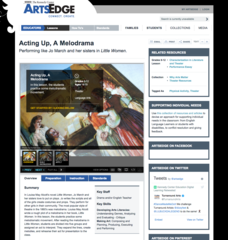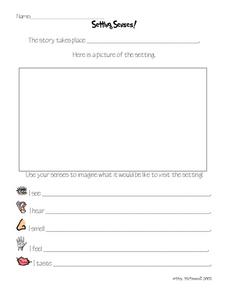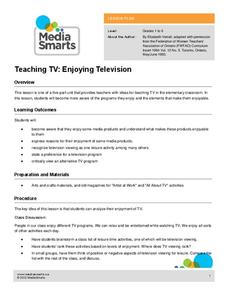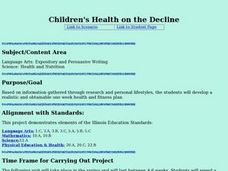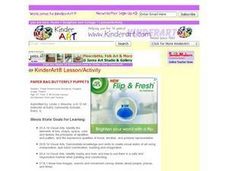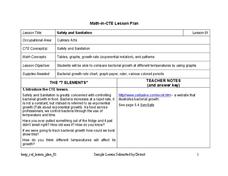Curated OER
Springfield Digital Storytelling Project #6: Grapes Commercial
Here is a fabulous instructional activity that should have your class very excited! They utilize the GRAPES formula in order to produce a commercial like ones we see on TV. Working in pairs, they must come up with a script, take video,...
Curated OER
Photographic Memories
Explore how photographs can represent a whole story to a viewer. Middle schoolers work on narrative writing techniques in this lesson, focusing on photographs from the New York Times to write first-person descriptive narratives....
Curated OER
The Power of Fiction
Students explore fiction that moves individuals to social action. In this literature lesson, students read The Jungle by Upton Sinclair and analyze its literary worth as well as its investigative journalism. Students investigate other...
Curated OER
Project-Based Learning: Improbable History
Students explore conflict. In this contemporary history instructional activity, students participate in 4 weekly activities that require them to research current conflicts and create time-travel cartoons that illustrate how the conflcits...
Curated OER
Tales from Arabia
Students read about Scheherazade and Aladdin and the Enchanted Lamp. In this literature/writing lesson, students understand the excitement of foreign places as the setting for a story. Students rewrite their own version of Scheherazade.
Curated OER
Looks Good Enough to Eat
Students examine food photography and the different techniques used by food stylists to make foods look appealing in advertisements. After learning some of the tricks of the trade, students plan and shoot their own food advertisements.
John F. Kennedy Center
Acting Up, A Melodrama: Performing Like Jo March and Her Sisters in Little Women
Lights, Camera, Action! Pupils read Little Women and create, act, and direct a melodrama that Jo March and her sisters would enjoy. The lesson plan comes complete with resources for the educator on melodrama as well as examples for drama...
Curated OER
Getting Ready to Write
Students watch an online slideshow that shows Cornelia Funke's transition from an illustrator to a writer. They discuss her writing process from the way she gathers ideas to how and where she writes. Next, they work in groups to choose a...
Curated OER
What a Character!
Students look at the role of characters in a story. For this character lesson, students discuss how different types of characters change the plot of the story. They see how storytellers use their body, face, and voice to tell stories.
Curated OER
Multi Media "self" Presentation
Students create a three-five minute presentation that visually illustrates major aspects of the their lives. Using Movie Works software as a base, they integrate video, photography, artwork, graphic elements, and sound to produce the...
Curated OER
The Composer's Blueprint
Students recognize AB and ABA form in music and distinguish between these two forms. They explore meaning of tempo and how to perform accents in written music.
Curated OER
Moving Rhythms
Learners explore the elements of tempo, beat and rhythm. They create rhythm patterns and an original dance. In groups, students perform their phrases for their peers. As a class, they explore choreographic principles, processes and...
Curated OER
Alexander Calder Cookies
Students create an original piece of edible art. In this edible art lesson, students decorate a sugar cookie in the style of Alexander Calder. Students view Calder's paintings and then create an original piece of art.
Curated OER
Gee's Bend Quilts
Third graders identify five new facts about the quilts, women, and community of Gee's Bend and finish their quilts by sewing the four edges of the quilt down. They review the color wheel and what the terms Primary, Secondary, Analogous,...
Curated OER
What is a Fable?
Learners read a variety of electronic Aesop's fables to define fable and moral, and write and illustrate an original fable. They then publish their fable using PowerPoint.
Curated OER
Common Nouns
In this common noun worksheet, students fill in blanks to complete 6 common nouns for each of 2 pictures, one of a young boy fishing, one of 2 children at a campground.
Curated OER
Setting Senses!
In this senses worksheet, students write what the setting of a story is, and then draw a picture of the setting. Students then imagine what it would be like to visit the setting, and list things they might see, hear, smell, feel and taste.
Curated OER
The First Amendment, What it Means and When Libel Comes in to Play
Students research three topics: The First Amendment, John Peter Zenger and his trial, and libel. In this journalism and libel lesson, students discuss things authority figures have done they disagree with and the anit-sedition law....
Curated OER
Poems That Work!
Students are introduced to the elements of poetry. As a class, they practice the correct way to read a poem and determine the author's audience. They identify similies and metaphors and determine the rhyme and meter. To end the...
Media Smarts
Teaching TV: Enjoying Television
What makes a TV program enjoyable? As an introduction to media analysis, kids identify their favorite programs and the elements they find engaging.
Hawaiʻi State Department of Education
Illustrating Text
Ideas like this are highly effective for helping build better reading comprehension. The class listens to an excerpt from a grade-appropriate text, and they discuss what clues or words helped them visualize the scene. They then read a...
Curated OER
Children's Health on the Decline
Demonstrate the importance of children's health with this cross-curricular lesson, which includes elements from health and science as well as expository writing. Middle schoolers develop realistic and obtainable one week health and...
Curated OER
Paper Bag Butterfly Puppets
Whether you're using it to tell stories, explore the letter b, or during a life science lesson, these butterfly puppets will be a hit. Youngsters use crayons, tissue paper, and paper bags to create butterfly puppets.
National Research Center for Career and Technical Education
Safety and Sanitation
Your microbiologists explore the graphing of exponential growth functions using bacteria, like e. coli and salmonella, in a well-written, career and technology lesson.








